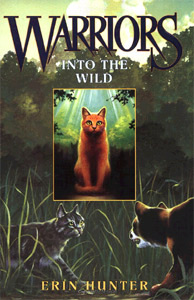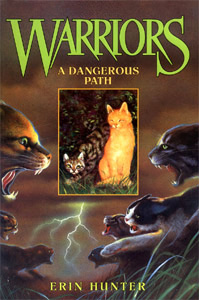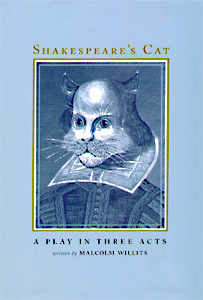 |
|
|
| Title: |
Shakespeare’s Cat: A Play in Three Acts |
| Author: |
Malcolm Willits |
| Illustrator: |
Bonnie Callahan |
| Publisher: |
Hypostyle Hall (Hollywood, CA), Sep 2004 |
| ISBN: |
0-399-23964-2 |
|
Hardcover, [vi] + 117 + [i] pages, USD $35.00 |
|
|
Take Disney’s The Aristocats, mix with Lloyd Webber’s Cats and Shakespeare’s… er, well, bits and pieces from throughout Shakespeare. Actually, aside from the Shakespearean blank verse, this seems more reminiscent of the spirit of Gilbert & Sullivan with maybe a little Brecht.
Disney’s The Aristocats was not officially inspired by any specific rich old lady leaving her fortune to her cats, and Bast knows this has happened many times. But the 1957 incident of 85-year-old Amelia Carson of Eureka, California leaving her million-dollar estate to her thirty cats was well-reported at the time. That is the actual event upon which Willits’ play is based, although it is about as close to the true event as Shakespeare’s Macbeth was to genuine 11th-century Scottish history.
Carson’s pampered cats are introduced reveling in luxury:
| CAT #2 |
They come, they come,
Fair Eureka’s finest, Amelia Carson’s cats,
Clad in hues of festive summer finery,
To tread our rustic forest paths with their coquetry.
Well-versed in all the arts to please a man,
They come here to cavort and give full grace
And measure to our annual Hoopla Ball. (pg. 3)
|
The revelry is interrupted by shocking news:
|
Enter a group of distressed Carson cats.
|
| CAT #1 |
Alarm! Alarm! |
| CAT #2 |
Oh, woe! Oh sad the hour. |
| CAT #3 |
Sad the day. |
| CAT #4 |
Amelia Carson’s dead! The only one who loved us, and she’s gone. |
| CAT #1 |
Resting in her orchard at the fading of the day,
Death’s chill, like a far-searching bird,
Alighted and took hold of her.
So slipped her life away,
As the soft closing of a noble mansion,
Each window put to sleep,
Each sheeted room of memories shut down. [etc.] (pg. 21) |
The cats know that they are Carson’s heirs, but they have no illusions that the humans who hoped to inherit her wealth will let it go:
|
Enter a terror-stricken cat.
|
| CAT |
The will’s been read,
Our benefactor’s intentions legally proclaimed.
There’s growing rage her money’s left to cushion us,
And feeling what’s been done can be undone. |
| CAPT. LACROIX |
There are those high-placed here,
Who can as easily efface a law
As an unschooled ancient mason
Unchisel from a Nile wall
All record of a Pharaoh’s reign.
Their power makes ventriloquists of judges,
Buys verdicts in a jury room,
And subjugates all honest lawyers,
If any can be found. (pgs. 25-26) |
A human mob sacks the Carson mansion, Captain Lacroix dies fighting heroically, and most of the cats are captured except for Smudge and Collette who escape in a desperate attempt to find help. In Act Two, they find Twilight Town, a slum community of abandoned pet and feral cats and dogs. As the seriously wounded Smudge recuperates, Collette enlists the aid of the unsophisticated yet naturally noble (and virile) Tomcat to help save the remaining Carson cats.
If Willits had continued in this vein, Shakespeare’s Cat might have been an offbeat but genuine masterpiece. Unfortunately, starting about halfway through Act Two he begins cramming in nudge-nudge wink-wink references to and guest appearances of everything from leftover Imperial Japanese World War II invaders, parodies of 1930s trench-coated private detectives and 1970s California Governor Jerry Brown, Zoroastrianism, Schrödinger’s Cat, Republic movie serials, Merlin the Magician, Orpheus and Eurydice, and the question of who really wrote Shakespeare’s plays; all portrayed by anthropomorphized cats and dogs. It becomes overly cutesy (if the basic concept is not overly cutesy in the first place). Much worse, it loses its focus and seems to drift aimlessly before returning to the plot at the last moment.
Your guess is as good as mine as to whether Shakespeare’s Cat was written to be actually performed or not. It seems theoretically possible, though it would cost a large fortune in costumes and constantly changing sets. Act Three, Scene One opens:
|
TOMCAT, COLLETTE, SNOOF, and the MYSTERIOUS CAT are sailing up the Mad River. A large picnic hamper is beside them. On the far embankment, they pass such things as a newly erected Stonehenge, a Roman fortress, the Tower of London under construction, and the famous 1616 engraving of the London cityscape. (pg. 85)
|
If we are not likely to see Shakespeare’s Cat performed, we can at least read its script; and enjoy holding it as an excellent piece of the book-designer’s art. It contains a tipped-in color frontispiece and numerous black-&-white illustrations by Bonnie Callahan, a photograph of Amelia Carson’s 1885 Victorian mansion (a tourist landmark in Eureka today); and a closing Sonnets from the Feline by Shirley Meech. The book is attractively printed on laid text and bound in gold-stamped back pseudo-leather in an edition of 1,000 copies. It is only available from its publisher: Hypostyle Hall, 6225 Hollywood Boulevard, Hollywood, California 90028; (323) 467-9459/fax 467-4536. $35.00 or $37.25 to California residents including sales tax; autographed upon request.
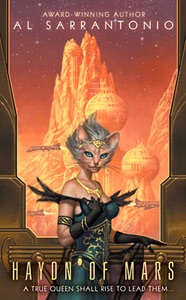 |
|
|
|
| Title: |
Haydn of Mars (Dec 2004)
|
| Author: |
Al Sarrantonio |
| Publisher: |
Ace Books (New York, NY), Dec 2004 |
| ISBN: |
0-441-01236-1 |
|
|
Paperback, 262 pages, USD $6.50 |
|
|
|
|
|
|
|
|
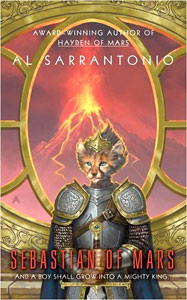 |
|
|
|
|
|
|
|
| Title: |
Masters of Mars |
| Author: |
Al Sarrantonio |
| Publisher: |
Ace Books (New York, NY), Oct 2005 |
| ISBN: |
0-441-01337-6 |
|
Paperback, 214 pages, USD $6.99 |
|
|
|
Al Sarrantonio… continues to push the boundaries of fantasy with a new trilogy set on a Mars that never was—but someday may be… (back-cover blurb)
Yes, this is fantasy rather than true science fiction. Sarrantonio’s colorful ‘distant future’ is similar to Bradbury’s Martian Chronicles or Burroughs’ Barsoom. It is exotic and poetic rather than realistic. Mars is covered with cities named after 19th and 20th century scientists and SF writers associated with the Red Planet, such as Lowell, Bradbury, Wells, Cassini, Schiaparelli, Sagan, and Robinson. But mankind has been extinct for so long that to the cat-people, humans are only legends:
“I must ask you,” he said, turning his attention back to the cards. He flipped a few of them over, exposing the faces of the great Martian feline composers. […]
I riffled through them, and brought out a particular one: a tall, proud feline with an abundant mane and kindly eyes. I handed it to Mighty. “This is a composer named Haydn. She was a musician, as were all of these.”
He nodded as he took the card. “I wondered why the game was called Jakra: music.”
“It is said that Haydn was named after another composer, one of the Old Ones,” I explained.
“These Old Ones are rubbish to me, also,” he said, throwing the card down onto the pile. “If they are unknown they might as well be ghosts, to frighten the children with at night. They are not real.”
“They were real,” I insisted. “It’s just that we don’t know much about them. Only that they were here before us.” (pgs. 60-61)
Sarrantonio’s feline Martians seem vaguely defined. For the most part they appear to match Matt Stawicki’s attractive cover painting of a feline head superimposed onto a human body. But they walk on all fours as casually as on two legs:
With a pipe, a smoke ring might linger for a full minute, but I preferred cigarettes. They were not easy to come by, though, and this, unfortunately, was my last one. Which was why I stood savoring it on a cliff overlooking beautiful Noachis Terra, with my home and the capital city of Wells at my back, studying a pink sunset just turning to blue at the far horizon, and wondering what any other sky might look like.
[…]
Kaylan [her husband], on all fours, moved up behind me and rested a paw lightly on the back of my leg before pulling himself up to full height. He stood silently for a moment gazing at the horizon before speaking. I turned to study his profile: his short mane swept back behind his ears, framing his almond eyes, slitted black, always deep pools of thought; his classically shaped face covered in bare white down, soft white whiskers barely visible astride his perfect, regal nose, brown-nostriled, the downturn of his mouth that transformed itself, brightening his entire visage when he laughed—which was not often these days. (pgs. 3-4)
A later scene at the Assembly of Mars is described as:
She [the Assembly Speaker] waved a languid paw at the podium, and I made my way quickly to it, passing Hadrian on all fours as he passed me, his pile of notes spilling from the pocket of his vest where they had been hastily shoved. (pg. 10)
Is it Haydn, Hadrian, or both who walk on all fours to address Mars’ feline government? Do these cat-people still have tails, or retractable claws? Do they go into heat? Are they the result of natural evolution or of bioengineering? Are Mars’ dogs as anthropomorphized as their cats? Read the novel if you are curious.
Mars’ population is divided into clans; the J’arn, K’fry, Yern, L’aag and many others. They range from cultured urbanites to nomadic raiders. The planet was a monarchy until recently, when enlightened King Augustus abdicated in favor of an idealistic but weak Republic. (Sarrantonio may have been inspired by Poland under Augustus II and III, during whose reigns (1697-1763) the ineffectual Parliament, whose deputies spent most of their time vetoing each other, let the country slide into anarchy.) Most Martians would not mind seeing a stronger monarchy restored. Haydn of Argyre, the young daughter of the last king, is the natural choice of the traditionalists. But the ambitious and powerful F’rar clan stages a coup and proclaims its own despotic leader, Frane, as the new queen.
Haydn is smuggled out of Wells by loyalists before she can be assassinated by Frane. Eager to reinstitute her father’s ideals, she discovers that her supporters consider her too inexperienced to actually rule—they are loyal to her but only as a figurehead. Before she can demand to be taken seriously, the loyalists are disastrously defeated in a battle with the F’rar. Haydn, pregnant, finds herself being carried to safety yet again, this time alone and incognito.
Haydn of Mars is a romance in both the old and modern sense. The first part of the novel spans several months during which Haydn’s husband is murdered and she is abducted or forced to flee several times by both saviors and traitors (handsome rogues and otherwise). During her search in disguise for the remaining loyalists, regrouped into a rebel underground led by the nobleman Kerl (her true love), she learns to genuinely stand on her own:
I did follow [the guard’s] advice and avoided the Fox. The Eagle was a rodent hole, but a serviceable one. Its very disrepute had kept the F’rar away. After paying the innkeeper extra to watch my horse and its wares, and warning him in a civil way (which I’m sure he was used to) that if anything untoward happened to either of them I would cut his throat, I ventured into the sunlight to get my bearings. (pg. 99)
Among the dangers she meets are another evolutionary offshoot of cats; the feral, cannibalistic baldies. Haydn is eventually reunited with the rebels to become their effective military leader. But among the factions she encounters during her search is the outlawed Science Guild, which has actual information about the shadowy Old Ones. This includes the ominous news that Mars is inhabitable only because it was ‘terraformed’ by these Old Ones, and the planet has been slowly losing its atmosphere since their disappearance. Mars will soon become lifeless unless the technology of terraforming can be rediscovered. Haydn is willing to support Newton and his scientists, but she has to win Mars’ civil war first.
Sebastian of Mars is set five years later; an entire generation among the cats. (Or maybe it is just that the Martian year is twice as long as Earth’s.) Sebastian, Haydn’s son and heir, has just reached his majority and is about to be crowned when the fragile peace established by Haydn breaks down. Just like World War I was followed by World War II, the new F’rar attempt to conquer all Mars is horrifically more violent and brutal. Sebastian, though brave enough, is such a sickly youth that his own supporters do not believe he can ever become the strong ruler that they need. Sebastian spends even more of the novel than Haydn did in hers disguised and on the run, in new areas of Mars.
Among the new factions he meets are the subterranean Downers, a feline equivalent physically of Gollum or the Morlocks but friendly enough; and the Romeny nomads:
The gypsy life!
Not for us the world of cats
In fancy pants
And fancy hats— [etc.] (pg. 103)
In the caverns under Olympus Mons, Sebastian discovers a fossil partial skeleton of the Old Ones, which helps to describe the cats by comparison:
For one thing it was much too long for a feline, and strangely proportioned. […] The torso was elongated to a strange degree, nearly half again my own height, and the fingers of the single hand that had been preserved were long and thin. The pelvis looked strange, also, as if this creature had never for a moment walked upon all fours, even in rest. (pgs. 50-51)
Sebastian of Mars ends with the F’rar apparently defeated once again. But will the peace hold this time? And the dissipation of Mars’ atmosphere is rapidly increasing. For the conclusion, read Queen of Mars, the final novel in the trilogy, scheduled for June 2006 release.
 |
|
|
| Title: |
Fleabee's Fortune |
| Author: |
Robin Jarvis |
| Illustrator: |
The author |
| Publisher: |
Hodder Children’s Books (London), Oct 2004 |
| ISBN: |
0-340-85510-X |
|
Paperback, 237 pages, UK £5.99 |
|
|
The Deptford Mice are back! British author/artist Jarvis skyrocketed into prominence in 1989 with The Dark Portal, the first of his uniquely gruesome Young Adult Furry horror novels. Six volumes were published up to 1995, three in The Deptford Mice Series (The Dark Portal, The Crystal Prison, and The Final Reckoning) telling the seemingly-hopeless efforts of the present-day mice to keep the rats’ evil god, Jupiter, from destroying the world; and three in The Deptford Histories series (The Alchymist's Cat, The Oaken Throne, and Thomas), set in the past to answer such questions as where Jupiter came from. The books have been popular enough to stay in print in Britain for over a decade, and U.S. hardcover and paperback editions have been published between 2000 and 2005.
Nine years later Jarvis has started a new trilogy, The Deptford Mouselets. ‘Mouselets’ suggests a more juvenile cast and/or readership than the previous books, and Book 1, Fleabee’s Fortune, seems to bear this out. Where the main characters in the previous novels are adults or older adolescents, those here are younger adolescents and children. Where the previous books are filled with suffering and horrific deaths, there is much menace and terror here but an astonishingly low number of actual fatalities. Although this is not a picture book, it contains many more drawings than the previous books; and for the first time Jarvis has done his own cover illustration.
The series title of ‘Mouselets’ is also misleading since it implies young mice. There are hardly any mice in Book 1; the protagonists are actually young rats. Fleabee’s Fortune is roughly a mirror image of The Dark Portal (and is set a year earlier), showing the unpleasant society of the rats in the Deptford sewers, on the other side of the rusty iron Grille that separates them from the kindlier Deptford Mice.
The tone is set right from the cast of Characters before the story begins. “Fleabee – a young ratgirl who is unlike the rest of her kind. She cannot bring herself to harm anything and spends her days dreaming. Scabmona – Fleabee’s younger sister. She is a true rat of Deptford and a real terror. She cannot wait to peel her first mouse. Klakkweena – Mother of Fleabee and Scabmona. She is a typical ugly ratwife who likes nothing better than to start an argument. Rancid Alf – Father of Fleabee and Scabmona. He is a lazy good-for-nothing, and is a perfect match for Klakkweena.” (pg. 7) All rats except for Fleabee have some disgusting trait, often embodied in their names such as Wormy Ned, Vinegar Pete, One-Eyed Jake and Leering Macky. Their miserable world in the sewers below London’s ancient districts of Deptford and Greenwich are constantly described by such terms as ‘dank’, ‘filthy’, ‘squalid’, ‘sickly’ and ‘festering’.
At first, Fleabee’s aversion to her fellow ratlings’ cruel games and sports (ratlings are given ‘throttledolls’ in their infancy which they are encouraged to torture and mistreat, to teach them how to play with their fellows) seems like no more than a crude literary device to avoid making her so unlikable as to put readers off. But it turns out to be a deliberate mystery. When all the other young-teen ratlings are exposed to the overpowering influence of their dark god, Jupiter, which fills them with bloodlust (“…their minds consumed with hatred and murder…”), Fleabee succumbs only temporarily before returning to her unnatural obsession with cleanliness, kindness, and open aboveground spaces. This obsession is potentially fatal since it is only a few days until the festival of Firstblood, the ratlings’ rite of passage by when each must have killed someone to prove their own bloodthirstiness or be slaughtered by their own playmates. Fleabee’s ability to withstand the influence of Jupiter’s evil may make her the first ratling receptive to the kindlier influence of the mice’s Green Mouse religion. It may equally make her a follower of the Raith Sidhe, the Three ancient rat gods who ruled before the coming of Jupiter (Lord Hobb, Bauchan, and Mabb—those interested in Celtic mythology will recognize an anthropomorphic version of pre-Christian Welsh religious beliefs), who have been waiting for centuries for a potential new high priestess who can restore them to power. Fleabee may have a powerful future if she can avoid discovery by Jupiter’s acolytes of her immunity to his spellcasting, and survive the festival of Firstblood.
The movie industry seems convinced that what young audiences want these days is lots of gross-out humor; fart and poop jokes. Jarvis may be following this rule, since what Fleabee’s Fortune lacks in shattered bones and characters skinned alive, it makes up for in disgusting imagery. Here is a rats’ feast:
“The scavenging parties had returned some time ago and an enormous spread of loathsome food had been laid out. It was a revolting buffet that only a rat could look at, let alone eat. […] fat bluebottles on sticks, a slime dip, gristle nibbles, the aptly named but tricky to eat crawling pie, assorted bones to gnaw at, nameless lump stew, maggot pasties, a mound of sweaty luncheon meat that had been ripped into jaw-cramming chunks and strips of green ham. […] A large bowl contained grey potato squelch covered in an impressive coating of blotchy green mould, there were frogspawn tartlets, humming cheese and fluffy toffee squeezeballs drizzled with an unidentifiable goo, lice fancies, sour milk and furry tomato trifle [etc., etc.]” (pgs. 194-195)
But no gory, in-your-face deaths. There is enough here that Fleabee’s Fortune will satisfy Jarvis’ fans, but it is certainly a ‘Deptford lite’ compared to the earlier novels. Let’s see what Whortle’s Hope, The Deptford Mouselets Book 2, is like. It is scheduled for April 2006.
Watership Down set a high standard for ‘realistic fantasy’ animal novels, superimposing a supposed minimum of intelligence and speech onto naturalistic abilities and behavior. There have been several good adventures about feral housecats; Solo's Journey, by Joy Smith Aiken, and In the Long Dark, by Brian Carter, to name two. Unfortunately, despite being well-written, these cat novels have tended to quickly go out of print and be forgotten.
The Warriors Young Adult series (recommended for readers of 10-up) by Erin Hunter should avoid this fate. Six volumes in the first series, published between February 2003 and October 2004, have already gone into hardcover and paperback editions and gotten generally favorable reviews. A sequel series, Warriors: The New Prophecy, began in May 2005.
Warriors is set among rival Clans of feral cats living in the semi-wilderness just outside a small town. Like Watership Down, there are an extensive language and religion among the cats. They are divided between the warriors who live free in their Clans, and the kittypets who live among the twolegs. The protagonist is a kittypet who dreams of feral glory. He escapes from his twolegnest into the forest where he is adopted by a warrior Clan that would not usually tolerate a ‘soft’ kittypet, but it has recently suffered several fatalities and needs recruits.
I cannot remember any other story in which the hero has so many name-changes. Rusty, a kittypet kit, is quickly adopted as the ThunderClan apprentice warrior Firepaw. He graduates into the full warrior Fireheart in Book 2, and that is his name until Book 6 when he becomes ThunderClan’s leader, Firestar. Most other cats undergo similar promotions; Graypaw becomes Graystripe, Cloudpaw becomes Cloudtail, and so on. The rank structure within the Clans provides some depth to the cats’ social order.
The similar names, especially with such recurring suffixes as -paw, -stripe, -claw, -fang and -pelt, make it difficult to keep straight which cats are in which Clans. There are four Clans: ThunderClan, RiverClan, WindClan and ShadowClan (plus StarClan, the Milky Way whose stars the cats believe are the spirits of deceased heroic warriors). Despite a strong emphasis on Clan loyalty, there is considerable movement between them. Fireheart’s best friend Graystripe becomes involved in a romance with the RiverClan she-cat Silverstream; and whether Graystripe should join RiverClan, and whose Clan their kits should belong to, is an important subplot. The political alliances between the four Clans is constantly changing, too. Today’s allies may be tomorrow’s enemies.
Fireheart is the nucleus who holds the story together. Unsure at first whether he belongs among the pampered but enslaved kittypets or the often-hungry but free warriors, he must win the respect of enough ThunderClan warriors to be accepted into the Clan. He becomes the protégé of the Clan’s wise leader, Bluestar, which both helps and hinders when some of his Clanmates become jealous. There are numerous subplots which show Fireheart’s slow maturing in both fighting ability and diplomacy among the Clans; but the main, ongoing conflict deals with his discovery that Tigerclaw, one of ThunderClan’s strongest and most trusted warriors, is actually plotting to murder his way into leadership. As both Fireheart and Tigerclaw rise in rank and prestige, their personal enmity increases in its potential to destroy all four Clans. The plot advances in a relatively straightforward manner (but with several surprises) in the first five volumes, then The Darkest Hour switches to some completely unexpected (but well-justified) new menaces to make the climax overwhelmingly ominous.
As usual with Watership Down-type stories, readers will have different opinions as to whether the ‘realistic’ animals are naturalistic enough or have been overly humanized. The anthropomorphization is generally nicely balanced. Some elements such as the monthly Gatherings of the four Clans (a sort of United Nations among the cat countries) stretch realistic animal behavior awfully far. Other elements such as the cats’ marking of Clan territories, their grooming behavior and the expressions of speech (“Mistyfoot mewed determinedly”; “‘Get back!’ Blackfoot yowled”; “‘Well done, all of you,’ he meowed”), attempt to keep the cats as naturalistic as possible. The result is more satisfying than in many other ‘realistic’ animal fantasies (such as the Guardians of Ga’hoole series with its armored, fire-carrying flying owls and its harp-playing snakes).
The six books contain helpful maps and lists of characters in each Clan. The location is unfortunately vague, with clues indicating both North America and Britain. It is probably Britain, considering place-names like Chelford and Druid Hollow, and since ‘Erin Hunter’ is actually a collaboration between two British authors, Kate Cary and Cherith Baldry; presumably the Americanized spellings (like ‘gray’ instead of ‘grey’) are to make the books ‘friendlier’ for American readers. A similar vagueness surrounds the authorship, with both the text and the art copyrighted in the name of Working Partners Limited. (The only credit for the attractive wraparound cover paintings and the half-dozen illustrated chapter headings, rotated among the approximately 30 chapters in each book, is on the rear jacket flap.)
The soap-opera melodrama is a bit simplistic for Young Adults, but there is enough depth (including frequent fatalities among sympathetic supporting characters) that the Warriors series should be enjoyable reading to all Furry fans.
Anthropomorphic books for review should be sent to Fred Patten, at:
Golden State Colonial Convalescent Hospital, 10830 Oxnard Street, North Hollywood, CA, 91606





